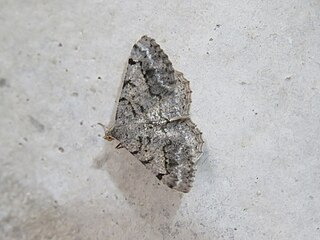
Cisthene is a genus of lichen moths in the family Erebidae. The genus was erected by Francis Walker in 1854.

Crambidia is a genus of moths in the family Erebidae. The genus was described by Packard in 1864.

Frederickia is a genus of moths in the family Geometridae described by Alexander Douglas Campbell Ferguson in 2008.
Chlorobaptella is a monotypic moth genus of the family Crambidae erected by Eugene G. Munroe in 1995. Its only species, Chlorobaptella rufistrigalis, was first described by William Barnes and James Halliday McDunnough in 1914. It is found in North America, where it has been recorded from California and Nevada. Moths in this genus are distinguished from moths in similar genera by their small palpi and obsolete tongues.

Xubida is a genus of moths of the family Crambidae.
Homocerynea is a monotypic moth genus of the family Erebidae. Its only species, Homocerynea cleoriformis, was found in the US state of Arizona. Both the genus and species were erected by William Barnes and James Halliday McDunnough in 1913.
Bertelia is a genus of snout moths. It was described by William Barnes and James Halliday McDunnough in 1913.
Coenochroa bipunctella, the sand dune panic grass moth, is a species of snout moth in the genus Coenochroa. It was described by William Barnes and James Halliday McDunnough in 1913, and is known from the United States, including Florida, Arizona and Maryland.
Macrorrhinia is a genus of snout moths. It was described by William Barnes and James Halliday McDunnough in 1913.

Galasa nigripunctalis is a species of snout moth in the genus Galasa. It was described by William Barnes and James Halliday McDunnough in 1913 and is known from the United States, including Arizona and Maryland.
Mescinia estrella is a species of snout moth in the genus Mescinia. It was described by William Barnes and James Halliday McDunnough in 1913, and is known from the Everglades in Florida, United States.
Negalasa is a monotypic snout moth genus. Its one species, Negalasa fumalis, is found in the US state of Arizona. Both the genus and species were described by William Barnes and James Halliday McDunnough in 1913 in the same paper.
Neodavisia singularis is a species of snout moth in the genus Neodavisia. It was described by William Barnes and James Halliday McDunnough in 1913 and is known from the US state of Florida.
Crambidia dusca is a moth of the family Erebidae. It was described by William Barnes and James Halliday McDunnough in 1913. It is found in North America, where it has been recorded from California and Ontario.
Crambidia pura, the pure lichen moth, is a moth of the family Erebidae. It was described by William Barnes and James Halliday McDunnough in 1913. It is found in North America, including Arizona, Florida, Georgia, Kentucky, Maryland, Mississippi, New Jersey, North Carolina, Ohio, Ontario, South Carolina, Tennessee, Texas and Wisconsin.
Cisthene conjuncta, the white-streaked lichen moth, is a moth of the family Erebidae. It was described by William Barnes and James Halliday McDunnough in 1913. It is found in southern Texas.
Cisthene subrufa, the Tamaulipan lichen moth, is a moth of the family Erebidae. It was described by William Barnes and James Halliday McDunnough in 1913. It is found in the United States in Arizona and from San Benito, Texas south to Veracruz in Mexico.

Givira lucretia is a moth in the family Cossidae first described by William Barnes and James Halliday McDunnough in 1913. It is found in North America, where it has been recorded from Arizona, Texas and Wyoming.
Atomopteryx solanalis, the carabid moth, is a moth in the family Crambidae. It is found in North America, where it has been recorded from Florida. The species was first described by William Barnes and James Halliday McDunnough in 1913.
Sericosema immaculata is a moth in the family Geometridae described by William Barnes and James Halliday McDunnough in 1913. It is found in North America.





